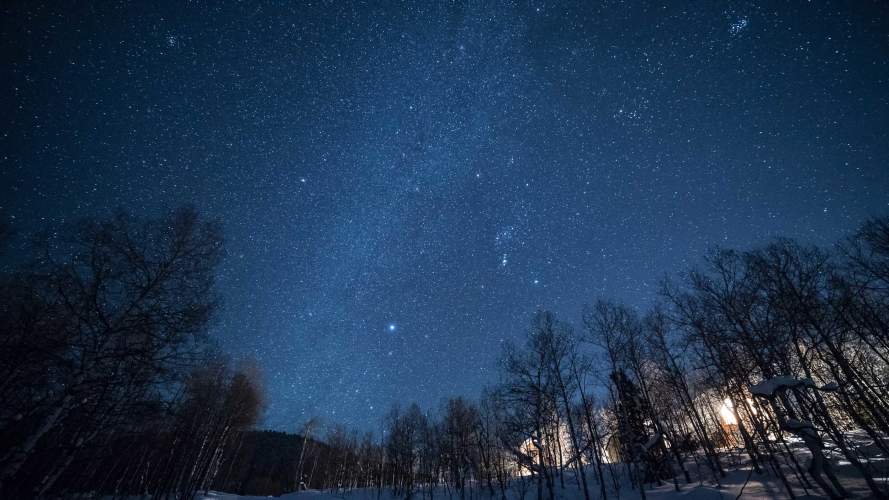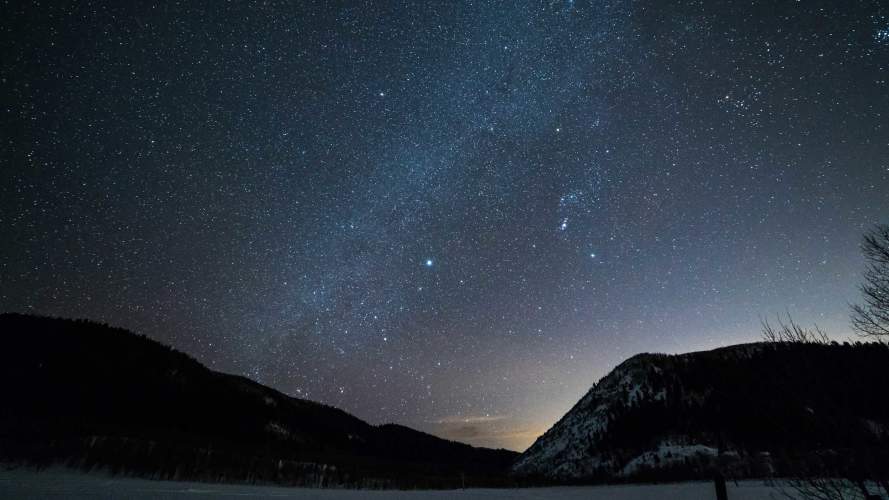"Access to a dark night sky—to see and be inspired by the universe as it really is—should be a human right, not a luxury for the chosen few," theoretical physicist Chanda Prescod-Weinstein states in her book The Disordered Cosmos: A Journey into Dark Matter, Spacetime, & Dreams Deferred.
The Milky Way, encapsulated with countless twinkling stars, an immerse band of dazzling light and color set against the darkened dome of the sky—the vastness and shocking beauty of space erase the internal humdrum, and the gazer is present, witnessing the scene. In those moments, peace and wonder gently hush the constant buzzing that comes with an electronically driven existence. One stargazing experience can put life in a new perspective.
And yet, Visit Utah's website reveals a sad truth, "Eighty percent of Americans live in an area where they cannot see the Milky Way due to the light pollution of the cities." Fortunately, Utah is committed to creating places to bask under the wonder of the celestian sky. "We are very proud that Utah currently leads the nation in dark sky preservation," exclaims Utah Office of Tourism's Public Relations Manager, Anna Loughridge. "We currently have 25 accredited DarkSky International (IDA) places."
Where to Find the Best Stargazing
So, where does a novice stargazer begin? With the Dark Skies Exploration: A Beginner's Guide, a free 12-page resource from Visit Utah. The easy-to-use guide outlines essential considerations and pro tips. Like, plan around moon phases. "Dark skies can range. It's important to be prepared for what that experience will be," Anna describes. "For stargazing, look at the moon cycle. A dark experience can range from a new moon with the best view of the Milky Way to a full moon where you can go for a hike or a ski." The guide also lists IDA-accredited places in Utah along with tips for appropriate nighttime wardrobe, gazing accessories, and replenishments.
Stargazing is a pursuit suited for any season, and the nocturnal scenery shifts throughout the year. In Utah, summer is the prime months to wonder at the Milky Way—when its illustrious color paints the sky throughout the night. In Autumn, the Galactic Core (AKA the Milky Way) is visible in the early evening, and during spring, it shines in the hours before daybreak. In the winter months, the Milky Way is not always visible. However, the cold and dark create some of the best starry experiences. "Winter is such a unique opportunity for stargazing. We lose the sun at 5 pm, which makes stargazing that much more accessible," Anna says.
For residents and visitors of the Wasatch Back, the most challenging part of embarking on a nocturnal adventure is choosing which of the four surrounding accredited dark sky state parks to visit: Jordanelle State Park, Rockport State Park, Wasatch Mountain State Park, or East Canyon State Park. "State Parks have shown a tremendous amount of leadership," Anna states. "A lot of these state parks offer dark sky programming. I encourage people to check each park's website."
What's unique about each of these five locations? Are there additional programs? Why visit?

Jordanelle State Park
Jordanelle State Park is the closest accredited dark sky space to Park City. The Provo River flows from the Uinta Mountains and fills Jordanelle Reservoir before winding down Provo Canyon to Utah Lake. Water enthusiasts delight in maritime play opportunities. For naturalists, the Rock Cliff Recreation area on the southeast side of the reservoir is Eden. The restored Nature Center bursts with ecological information and educational taxidermy. And when the sun sets, Rock Cliff is the darkest corner in the park. The paved walking paths and boardwalks invite speculators to hunker down and look up! During snowy times, snowshoes are the best tool for meandering the area. Pack lots of warm clothes, hot drinks, and chairs to create the perfect spot for stargazing.
During the warm months, Gypsy Glamps is a luxury camping experience at Jordanelle State Park. An overnight stay is a perfect way to experience complete stary immersion.
Rockport State Park
Rockport State Park is between Wanship and Peoa on State Road 32, with the Wasatch Mountains spreading to the west and the Uinta Mountains dominating the eastern skyline. These mountain ranges create a geological halo, protecting Rockport from light pollution. The park facilitates reoccurring programming to educate visitors about best dark sky practices and why dark skies are essential for nocturnal animals. The most popular outings include the Scorpion Walk and Star Talk presentations.
Wasatch Mountain State Park
Wasatch Mountain State Park is the latest Wasatch Back state park to receive IDA accreditation. The 23,000-acre preserve kisses the perimeters of Midway and hosts two golf courses, a seasonal campground with abundant hiking and walking trails, and the Soldier Hollow Nordic Center. Winter stargazing on skis is unforgettable, and the Nordic Center hosts special twilight hours on Tuesdays and Thursdays, where partially lit cross-country and skate skiing trails are open until 6:30 pm.
The Wasatch Mountain State Park 2024 events calendar features monthly moonlit snowshoe hikes from 6:30 to 9:30 pm. In April, Wasatch Mountain State Park will celebrate its dark skies with a family-friendly event featuring educational stargazing, hands-on activities, and treats.
East Canyon State Park
East Canyon State Park lies within the towering walls of East Canyon on State Route 65. Winter road closures make this area an ideal place to visit in the warmer months. The park's focal point is East Canyon Reservoir, a popular recreation spot with mariners and anglers. The best way to enjoy the dark sky accreditation is an overnight stay with options ranging from Old West wagon rentals to RV trailer camping to yurts to cabins and the ultimate choice for stargazing…hammock camping. Check the website for dark sky programming schedules.

Dark Sky Park Habitats
"Dark sky exploration is about tapping into that imaginative side of yourself that we don't always get to experience," Anna says. Visiting one of the Dark Sky accredited parks surrounding Park City opens the gates of wonderment for human visitors. The dark sky protected areas have an essential role beyond recreation and spiritual fulfillment; they are a safe habitat for nocturnal animals like American barn owls, badgers, big brown bats, boreal chorus frogs, common nighthawks, coyotes, deer, great-horned owls, fireflies, kangaroo rats, raccoons, scorpions, and tiger salamanders. "It's about what's below, too. It's about this entire ecosystem system. When dark sky preservation happens, these ecosystems are preserved," Anna explains.
Fortunately, Utah is committed to preserving, protecting, and growing dark sky havens. "It's so important to protect our wildlife from light pollution and provide stargazing opportunities," Anna states. "Dark sky preservation and astrotoursim (astronomy-based tourism) is a responsible and sustainable form of tourism." Plus, it's economically beneficial. "Astrotourism could lead to an estimated $5.8 billion in spending in the Colorado Plateau support over 100,000 new jobs in the next ten years."

Dark Sky Parks Harbor Wellness
We have an unusual opportunity in Utah to witness the starry sky in wonder. Stargazing is an ancient nighttime ritual that some people may experience for the first time thanks to the protected dark sky areas. Anna sums it up eloquently: "Wellness takes on a different meaning in Utah. It really is about seeing the Milky Way for the first time in your life." Or maybe it's seeing the Milky Way for the thousandth time and wondering how celestial illumination never becomes tiresome.
